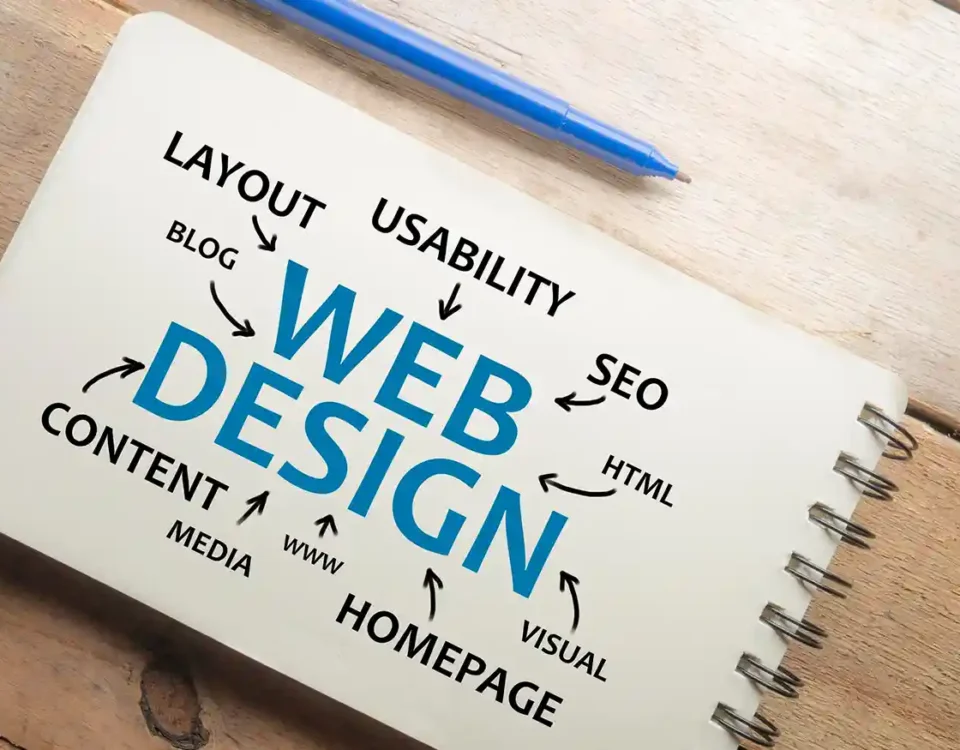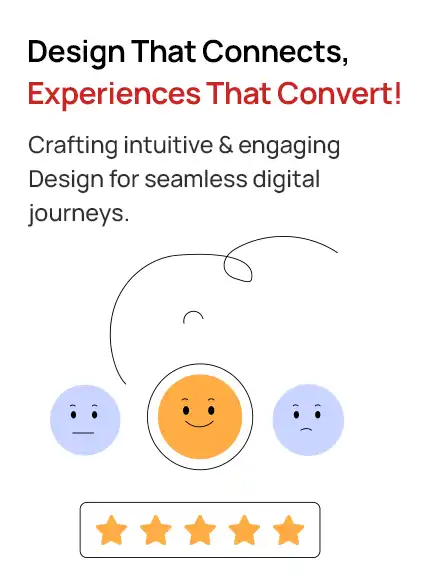
Branding for Therapists: A Guide to Client Connection
July 11, 2025
The Ultimate Guide to Pitch Decks for Startups
July 16, 2025
Branding for Therapists: A Guide to Client Connection
July 11, 2025
The Ultimate Guide to Pitch Decks for Startups
July 16, 2025The Rise of User Interface Design in Chicago: A Local Perspective
July 14, 2025
- 22 min to Read
Introduction
Did you know that Chicago is becoming a major city for digital design?
With thousands of tech companies and a fast-growing startup scene, more and more businesses here are focusing on how their websites and apps look and feel. This is where user interface (UI) design comes in.
UI design is all about what people see and click on when they use a digital product — like buttons, menus, forms, and layouts. Whether you're shopping online, using a banking app, or reading news on your phone, good UI design makes everything easier to use.
While cities like New York and San Francisco are known for tech, Chicago is quietly building a strong name in UI design. The city has top design schools, skilled designers, and agencies that work with companies across the country. From healthcare and finance to retail and education, Chicago’s design work is showing up everywhere.
In this article, we’ll explore how UI design is growing in Chicago — where it started, what’s happening now, and why the city is becoming a go-to place for great digital design.
What Is User Interface (UI) Design?
Before we dive into what’s happening in Chicago, let’s quickly understand what user interface (UI) design really means.
UI design is all about how a digital product looks and works when someone uses it. That includes everything from the layout of a website to the buttons on a mobile app, the icons you click, and the way a form appears on your screen. It’s what users see, touch, and interact with.
But it’s not just about looks. Good UI design makes things easy to use. It helps people find what they need quickly, complete tasks without frustration, and enjoy the experience — whether they’re booking a flight, checking their bank balance, or shopping online.
In today’s digital world, people expect fast, simple, and smooth interactions. That’s why UI design is more important than ever. From healthcare apps to education platforms and online stores, every industry is now investing in design that puts users first.
UI sits at the center of that experience — connecting people with technology in a way that feels effortless.
Why Chicago? A City Shaping the Future of User Interface Design
So, what makes Chicago stand out when it comes to user interface design?
While places like San Francisco and New York often get the spotlight for tech and design, Chicago has been growing its own digital design scene quietly but steadily. The city has everything needed to support a strong UI design community — top-tier schools, innovative companies, talented designers, and a culture that values smart, user-friendly solutions.
Here’s why more businesses and design professionals are turning their attention to Chicago:
1. A Strong Foundation in Design Education
Chicago is home to some of the country’s best design programs, including:
- School of the Art Institute of Chicago (SAIC)
- Illinois Institute of Technology’s Institute of Design (IIT-ID)
- Columbia College Chicago
These institutions teach students more than just how to make things look good — they focus on human-centered design, digital products, and real-world problem solving. Graduates enter the industry ready to build interfaces that are not only beautiful but functional and easy to use.
In addition to these universities, design bootcamps like General Assembly and Flatiron School offer hands-on UI/UX training. These programs give aspiring designers the tools they need to quickly start careers in tech, making Chicago a solid pipeline for fresh talent.
2. A Growing Tech and Startup Community
Chicago has a long history of innovation, and that spirit continues with a tech scene that’s rapidly expanding. Hubs like 1871, mHUB, and TechNexus support hundreds of startups, many of which rely heavily on intuitive and engaging user interfaces.
Companies like Cameo, ActiveCampaign, and Kin Insurance are just a few local success stories. These brands have grown by building digital products that focus on user experience — proving that strong UI design can directly support business success.
As these startups scale, so does their need for skilled UI designers who can create products that are clean, fast, and easy to navigate.
3. High-Quality Talent Without the High Costs
One of Chicago’s biggest strengths is its balance of quality and affordability. Compared to cities like San Francisco, Chicago offers access to talented designers at more manageable costs — a big plus for startups and mid-size companies that want great design without overspending.
But it’s not just about price. Chicago designers are known for their collaborative and practical mindset. The city’s Midwestern values — grounded in teamwork, honesty, and clear communication — shape a design approach that’s thoughtful, user-focused, and results-driven.
This culture leads to UI design that doesn’t just look good on screen but works well in the real world.
How UI Design in Chicago Has Evolved
Over the past 10 years, UI design in Chicago has come a long way. What once was a scene dominated by traditional graphic design and advertising agencies has now grown into a forward-thinking, user-focused digital design industry.
Back then, most local design work centered on print materials, branding, and visual advertising. Designers were focused on how things looked — brochures, logos, billboards — not necessarily how people interacted with them.
But as technology shifted, so did the work. The rise of smartphones, web apps, and SaaS products changed everything. Businesses needed interfaces that didn’t just look good, but worked well — across devices, browsers, and user needs. And Chicago’s creative community was quick to respond.
Local agencies, product studios, and independent designers began moving away from static visuals and toward functional, responsive, and user-friendly interfaces.
Here’s a quick look at how things have changed:
| Then | Now |
|---|---|
| Focused on print and branding | Focused on digital products: web and mobile apps |
| Design was about appearance | Design now supports usability and accessibility |
| Static layouts and pages | Interactive, responsive systems built for users |
| One-off designs | Scalable, component-based UI frameworks |
Today, UI designers in Chicago are fully involved in the product development process. They work closely with developers, strategists, and researchers to plan out user journeys, build interactive wireframes, and ensure designs are accessible to all users — including those with disabilities.
In short, Chicago’s UI professionals are no longer just creating visuals. They’re designing digital experiences — ones that are clean, intuitive, and built for the way people actually use technology.
Current Trends in User Interface Design (Chicago-Style)
Design is always changing — and in a city as dynamic as Chicago, it’s evolving with purpose. Today’s UI designers in Chicago aren’t just following trends; they’re adapting them to fit real users, practical needs, and diverse industries.
Here are some of the most noticeable trends shaping user interface design in Chicago right now:
1. Minimalist, But With a Purpose
Simplicity is still in — but Chicago designers are using it smartly. The focus is on clean layouts, meaningful white space, and purposeful typography that guides users naturally. Instead of overwhelming visuals, designs are more focused, allowing users to navigate apps and websites with ease and confidence.
This approach works especially well in industries like finance and healthcare, where clarity matters just as much as creativity.
2. Microinteractions That Add Personality
Whether it’s a button that gently pulses when hovered or a swipe animation that confirms a task — microinteractions are everywhere. These small, thoughtful touches give users feedback, improve usability, and add a sense of delight.
Chicago-based fintech and SaaS companies are especially leaning into these details to make their platforms feel more human, responsive, and trustworthy.
3. Design Systems and Modular UI
To build digital products that scale, many Chicago design teams are now using design systems — shared libraries of reusable UI components. Some follow popular frameworks like Google’s Material Design, while others develop their own atomic design systems tailored to their product or brand.
The result? Faster design workflows, consistent user experiences, and easier collaboration between designers and developers.
4. Accessibility Is No Longer Optional
In a city that values equity and public service, accessible UI design is becoming the standard. Whether it’s designing for color contrast, screen reader support, or keyboard navigation, more teams are prioritizing inclusive design from the start.
This is especially important in Chicago’s healthcare, education, and government sectors, where digital access can directly impact people’s lives.
5. Smarter Tools with AI Support
AI is starting to play a helpful (but not overpowering) role in the design process. Tools like Figma AI, Framer, and UX writing assistants are being used by Chicago designers to brainstorm faster, test layouts, and automate repetitive tasks — while still keeping the human touch intact.
These tools don’t replace designers — they free up time for more creative thinking and user research, which ultimately leads to better interfaces.
Community & Culture: What Makes Chicago’s UI Scene Unique
UI design is about more than just clean layouts and smart buttons — it’s about people. Behind every great interface is a team of designers, developers, and strategists working together to make technology easier to use. In Chicago, that collaboration runs deep.
What truly sets the city’s UI design scene apart is its strong sense of community, shared learning, and cultural diversity — all of which influence the way interfaces are built and experienced.
Local Events That Bring Designers Together
Chicago’s design community is active, welcoming, and constantly sharing ideas. Throughout the year, local events and meetups give UI professionals a chance to connect, collaborate, and learn from one another.
- Chicago Camps A well-known organizer of UX and design conferences, bringing in experts from across the country to share insights and trends.
- Design Night Chicago A monthly gathering where creatives meet to talk design, showcase work, and exchange ideas in a relaxed, friendly setting.
- AIGA Chicago Offers mentoring programs, hands-on workshops, and professional events — covering topics like accessibility, typography, and prototyping for UI.
These events aren’t just about networking — they’re about building a local design culture that’s open, inclusive, and constantly evolving.
Diversity That Drives Design
Chicago is one of the most diverse cities in the U.S., and that diversity is reflected in its design work. Local UI designers come from different backgrounds, communities, and cultures — and that helps them build digital products that speak to a wider, more realistic audience.
This kind of representation matters. It influences everything from color choices and language to layout decisions and accessibility standards. Interfaces built in Chicago often feel more human because they’re created by teams who understand different user needs firsthand.
A Wide Range of Industries, A Broad View of Users
Unlike tech-heavy cities that focus mainly on apps and startups, Chicago’s UI designers often work across a broad mix of industries — including:
- Healthcare
- Finance
- Education
- Retail
- Transportation
- Nonprofits and local government
This cross-industry experience helps Chicago designers solve real-world problems through UI — whether it's building patient portals that are easy to use or designing tools that simplify financial planning for everyday users.
Challenges for UI Designers in Chicago
Like any growing design scene, Chicago’s UI community faces its own set of challenges. While the city has many strengths — from talent and culture to affordability — there are still hurdles that designers and agencies often have to navigate.
Here are a few of the key challenges shaping the local UI landscape:
1. Balancing Modern Design with Outdated Tech
Many Chicago-based businesses, especially in sectors like healthcare, logistics, and government, still operate on legacy systems — platforms that are older, harder to update, and often not built with modern UI in mind.
For designers, this can make implementing clean, responsive, and interactive interfaces more difficult. They’re often tasked with finding creative workarounds — bringing in modern aesthetics and usability without breaking the underlying system.
It’s not impossible, but it takes smart thinking and technical collaboration.
2. Attracting and Retaining Senior Talent
While Chicago has an impressive pool of design talent, some experienced UI designers still gravitate toward coastal cities like New York or San Francisco — often in search of higher-profile projects or bigger salaries.
This creates a gap in mid-to-senior level talent, especially for agencies and startups looking to build experienced design teams.
The good news? With more companies embracing remote and hybrid work, many designers are returning to Chicago — or choosing to stay — knowing they can work with national clients while enjoying the city’s quality of life and lower costs.
3. Competing With Coastal Expectations
Chicago design firms are often compared to their coastal counterparts — and not always on a level playing field. Clients sometimes assume that top-tier design only comes from Silicon Valley or Brooklyn, even though many Chicago-based teams deliver work that’s just as innovative and polished.
To win national clients, local agencies and freelancers often need to go the extra mile to prove their value — offering exceptional design at more competitive rates, while still staying up to date with the latest tools, trends, and best practices.
Despite these challenges, Chicago’s UI design community is known for its resilience. Designers here are practical, resourceful, and deeply connected to both their craft and their city. Rather than chasing trends, they focus on building interfaces that work — and that leave a real impact.
The Future of UI Design in Chicago: What Clients Should Know
As digital becomes the default, the role of user interface design is more critical than ever. From improving customer experience to driving conversions, great UI isn’t just a “nice to have” — it’s a competitive advantage.
And Chicago is quickly becoming one of the best places to find it.
Here’s what forward-thinking businesses and organizations can expect from the future of UI design in Chicago:
1. A Growing Pool of Skilled Designers
UI/UX education is expanding across the city — not just in top design schools, but also through bootcamps, certificate programs, and soon, high school and university partnerships. This means more local talent trained in current tools, design systems, and real-world usability principles.
For clients, this translates to a reliable pipeline of skilled, adaptable designers ready to support both startup and enterprise-level projects.
2. Innovation in Emerging Interfaces
As technologies like AR and VR become more common in fields like architecture, logistics, and manufacturing, UI design is expanding beyond the screen. Chicago designers are already exploring ways to build intuitive interfaces for 3D, voice, and spatial experiences. If your company is moving toward immersive digital environments, you’ll find forward-looking partners right here in the city.
3. Inclusive, Human-Centered Design by Default
Chicago’s diverse population and strong public-sector presence are pushing accessibility and inclusivity forward. Local agencies and freelancers are building with real-world users in mind — across language, culture, age, and ability.
This means more usable, ethical, and human designs — especially important for companies in healthcare, education, finance, and civic services.
4. National-Quality Work, Local Approach
With remote work now a norm, many Chicago-based designers and studios are serving clients across the country — delivering big-agency results with a Midwestern approach: practical, thoughtful, and grounded in collaboration.
For businesses looking for top-tier UI design without coastal price tags, Chicago offers the best of both worlds.
In short, the future of UI design in Chicago is about scale, skill, and strategy. Whether you're building a new product, refreshing your platform, or looking to improve digital experience — Chicago is becoming one of the most reliable places to start.
How Upclues Supports User Interface Design in Chicago
As more businesses in Chicago go digital, the need for smart, easy-to-use interfaces is growing fast.
At Upclues, we help companies create user interfaces that are clear, modern, and built with people in mind. Our goal is simple — to make digital products that work better and feel better to use.
We Understand the Local Market
Chicago is home to many different industries — like healthcare, finance, education, logistics, and retail. Each one has unique needs when it comes to digital products. That’s why we take time to understand your business, your audience, and your goals before we start designing.
Whether you're a new startup or an established brand, we shape the interface around your real users — so everything feels natural, not confusing.
People-First Design, Always
Good user interface design is about more than looks. It’s about helping people get things done — quickly and without frustration. At Upclues, we design layouts, buttons, and flows that are simple, intuitive, and easy to follow.
We also make sure everything is responsive — so your product works on desktop, tablet, and mobile — and we keep accessibility in mind, so that everyone, including people with disabilities, can use your product with ease.
Working with You, Not Just for You
We believe the best results come from working closely with your team. Whether you already have developers, a product manager, or are starting fresh, we fit in where you need us most.
We share ideas, give updates often, and keep the process simple and transparent — no complicated jargon, no surprises.
Scalable UI Systems, Not Just Screens
Design isn’t a one-time task. Your product will grow, and your interface needs to grow with it. That’s why we build design systems — reusable parts, components, and style guides — so your team can scale the product easily in the future.
This means you don’t just get a few nice pages — you get a design foundation that supports long-term growth.
At Upclues, we’re proud to support the growing demand for user interface design in Chicago. We focus on clear thinking, simple tools, and results that feel right — for your users and your business.
Final Thoughts: Why Chicago Matters in UI Design
Today, digital products are part of everyday life — from how we shop and bank to how we learn and access healthcare. And behind every great digital experience is a clear, easy-to-use interface.
When users can navigate a product without confusion, they’re more likely to stay, engage, and return. That’s why UI design plays such an important role in business success.
In Chicago, UI design goes beyond how things look. It’s about making products that work well for everyone — simple, functional, and built with real people in mind.
The city’s strong design education, growing tech industry, and focus on collaboration make it a great place for thoughtful, user-first design.
At Upclues, we’re proud to be part of this growing design community. We help businesses create digital products that are not only easy to use but also meaningful and effective. Whether you’re just starting out or improving an existing product, our team brings practical, people-focused design to every project.
Chicago has the talent and mindset to lead the future of UI — and we’re here to help make it happen.
Frequently Asked Questions About User Interface in Design Chicago
1.What makes a great UI design agency in Chicago?
A great UI design agency isn’t just about making things look pretty — it’s about designing with purpose. In Chicago, where tech and creativity meet, the best agencies:
- Take time to understand your business and audience
- Create designs that feel intuitive and easy to use
- Share real projects and measurable results
- Stay current with tools like Figma or Adobe XD
- Communicate openly and deliver on time Most importantly, they care about solving real problems, not just delivering screens. That’s what sets a good agency apart from a great one.
- Basic website: $1K–$5K
- Startup or SaaS product: $3K–$8K
- Complex apps/platforms: $8k+ Some agencies offer fixed packages, while others work hourly. It’s best to share your scope and goals — a good agency will guide you through what fits your budget without cutting corners.
2 How much does UI/UX design cost in Chicago?
The cost really depends on what you need. A simple landing page design might start around $500, while a full-scale website or app design can go upwards of $5,000 to $20,000. Here’s a quick idea:
3. Is there a difference between UI and UX?
Yes — and it’s an important one. UI (User Interface) is what you see: the buttons, colors, layout, and fonts. It’s how your website or app looks.
UX (User Experience) is how it works: the flow, how easy it is to use, and how it makes the user feel. Here’s a simple way to put it: UI is the design of the cup. UX is how easy it is to drink from it. Great products need both — they should look good and work seamlessly.
Explore the Future of UI in Chicago
Connect with local experts who understand the pulse of UI trends right here in Chicago.





